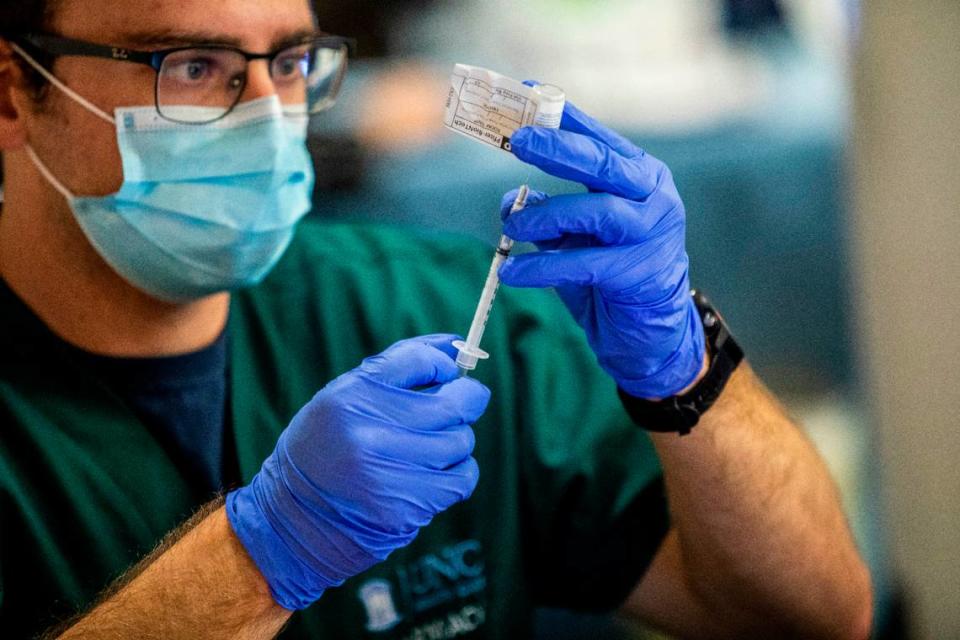At vaccine time, don’t forget about shingles. Here’s who should get shots and when.
New vaccines this fall are helping us avoid last year’s “tripledemic,” a dangerous combination of COVID, the flu and RSV.
This is the first fall with an RSV vaccine, recommended for older adults and a select few with other health complications. Plus, a new-and-improved COVID vaccine is expected by this weekend, the Centers for Disease Control and Prevention announced.
You can start making appointments for your updated shot. CVS Pharmacy already has doses in stock, while you can make appointments at Walgreens as early as Monday.
And you can tack on a flu shot while you’re at it, double-vaxxing to prevent serious cases of these illnesses.
While we’re talking about vaccines, we should highlight important vaccinations against shingles, a common viral infection in older adults (though you can get it at any age).
The shingles vaccine is the only way to protect against shingles and postherpetic neuralgia (or PHN), the infection’s most common complication.
Here’s what to know about shingles, PHN and protecting yourself against both by getting vaccinated.
What are shingles?
Shingles are a viral infection in the skin’s nerves that cause pain, tingling or burning, along with itchy rashes or blisters.
The rash or blisters usually last from three to 10 days, then they fade. They usually appear on only one side of your body, commonly around the waist or rib cage. The rash is associated with nerve inflammation beneath the skin.
You can also get a fever, upset stomach, headache and chills.

How common are shingles?
Very common. About one in three people in the United States will develop shingles, which is also known as herpes zoster.
You can get shingles if you’ve ever had chickenpox. Often, the pain of shingles begins before you notice the rash, per the Mayo Clinic.
While adults 50 and older are at the highest risk, children can also develop shingles.
Who should get a shingles shot?
Adults 50 and older should get two doses of the shingles vaccine Shingrix.
The doses should be separated by two or six months, the CDC says.
Adults 19 and older who have weak immune systems — due to factors like cancer treatment or other immunosuppressive drugs, like steroids — should also get two doses of Singrix in the same time frame.
Your risk of shingles increases as you age.

How can I get a shingles vaccine?
National chain pharmacies, like CVS Pharmacy and Walgreens, offer Shingrix shots during COVID shot appointments.
You can schedule your appointment at these pharmacies using their online scheduler tools at walgreens.com/findcare/schedule-vaccine and cvs.com/vaccine.
You can also get these vaccines at your doctor’s office or other medical offices and clinics.
Dr. David Wohl, infectious disease expert with UNC Health, wants to remind patients that shingles shots are important, though getting vaccinated against COVID and the flu — and RSV, if applicable — is a more urgent task.
“There is much less urgency for the shingles shot, and I would wait to give that in preference of the others,” he said.
Does chickenpox cause shingles?
Yes.
“Anyone who has had chickenpox can develop shingles because the virus remains in the nerve cells of the body after the chickenpox infection clears,” said NC Department of Health and Human Services spokesperson Summer Tonizzo.
“The virus can reappear years later, causing shingles.”

How effective is the shingles vaccine?
90% to 95% effective.
The shingles vaccine is a two-dose series and provides protection for at least seven years, Tonizzo said.
“It’s safe in everyone and is 90% to 95% effective. So it’s excellent but not perfect,” said Dr. David J. Weber, infectious disease expert with UNC Health, in a blogpost.
The CDC says Shingrix is 97% effective in preventing shingles in adults ages 50 to 69 with healthy immune systems, and 91% effective for adults over 70.
The most common side effects of the vaccine are:
Mild to moderate pain
Swelling in the arm where the vaccine was administered
What is postherpetic neuralgia (PHN) from shingles?
Postherpetic neuralgia (PHN) is the most common long-term complication of shingles.
According to the May Clinic, PHN causes:
Pain that lasts three months or longer after the shingles rash has healed. Pain can feel burning, sharp and jabbing. It also may feel deep and aching.
Not being able to stand light touch. PHN often makes it unbearable to feel clothing touch the affected skin.
Itching or loss of feeling. PHN can cause an itchy feeling or numbness, though it’s less often.
There is no cure for PHN, though there are treatments to help symptoms (which, for most people, get better over time).
The risk of PHN gets lower if you start taking antiviral medication within 72 hours of developing shingles.
Getting the two-dose Shingrix series is one way to lower your risk of developing PHN (and shingles).
Adults can now get the RSV vaccine. Here’s who should get the shot and when
Is it OK to get the flu, COVID and RSV shots at the same time? A UNC doctor explains


